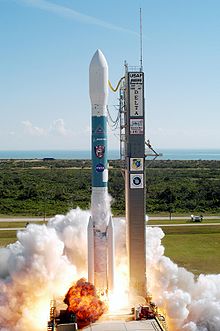Swift (satellite)
| Swift | |
|---|---|

|
|
| Type: | Research satellite |
| Country: |
|
| Operator: | NASA |
| COSPAR-ID : | 2004-047A |
| Mission dates | |
| Dimensions: | 1331 kg |
| Begin: | November 20, 2004, 17:16 UTC |
| Starting place: | Cape Canaveral LC-17A |
| Launcher: | Delta II 7320-10C D-309 |
| Status: | in operation |
| Orbit data | |
| Rotation time : | 96.6 min |
| Orbit inclination : | 20.6 ° |
| Apogee height : | 604 km |
| Perigee height : | 584 km |
Swift , officially Neil Gehrels Swift Observatory , and Explorer 84 or Swift Gamma Ray Explorer is a research satellite of NASA with British and Italian participation, gamma-ray bursts detected and investigated. Swift was launched from Cape Canaveral on November 20, 2004 with a Delta II 7320-10C rocket and is in a circular orbit about 600 km above the earth's surface with an orbit inclination of 20.6 °. The satellite weighs 1470 kg and is 5.57 m high and does not carry any consumables. It is supplied by two solar panels with a span of 5.41 m and an output of 1040 watts. An extrapolation showed that it should remain functional until around 2022 , although the original operation was only scheduled for two years.
mission
Swift's goal is to locate short-lived gamma-ray bursts as quickly and accurately as possible . In this way, further observations should be able to be directed to the correct object while the gamma-ray flash continues to glow. The Burst Alert Telescope (BAT) detects gamma-ray bursts in the photon energy range of 15 to 150 keV and has a wide field of view of approx. 2 steradian , it has an angular diameter of approx. 90 °. Around 100 gamma-ray bursts should be detected per year. The instrument can determine the position of a gamma-ray burst in the sky to within 1 to 4 arc minutes . This allows the X-Ray Telescope (XRT) to be aimed at the source of the gamma-ray flash and examine the afterglow in the X-ray range . This X-ray telescope , which works in the range of photon energies from 300 eV to 3 keV, determines the position of the source with an accuracy of 3 to 5 arc seconds and also records X-ray spectra. Finally, the Ultraviolet / Optical Telescope (UVOT) , a telescope with a 30 cm mirror diameter that works in the optical and ultraviolet range (170 to 650 nm wavelength), can be aimed at the source and determine its position with an accuracy of 0.3 arc seconds. Spectra are also recorded with this telescope.
Observations (selection)
- On September 4, 2005, the strongest ever documented gamma-ray flash was measured (distance: approx. 13 billion light years ).
- On February 18, 2006, 33 minutes was by far the longest gamma-ray flash from an object 440 million light-years away.
- On March 19, 2008 the strongest gamma ray burst to date, cataloged as GRB 080319B , was observed. It was 2.5 million times brighter than the most luminous supernova observed to date .
- On April 23, 2009, the most distant gamma-ray burst was registered at a distance of 13.1 billion light years.
- On June 21, 2010, the absolutely strongest gamma-ray flash with the name GRB 100621A was registered, which caused the Swift measuring instruments to fail for a short time.
- On June 3, 2013, the gamma-ray burst was named GRB 130603B registered
- On January 22nd, 2014 the UVOT instrument with SN 2014J was observed in the galaxy M82, the closest supernova for 20 years
- On June 15, 2015, activity was recorded at black hole V404 Cygni . Further observation led to the discovery of visible light in the area of the black hole.
Web links
- Swift site (English)
- Wissenschaft.de: Swift satellite observes transition from lightning to afterglow for the first time ( Memento from December 18, 2005 in the Internet Archive )
Individual evidence
- ↑ Orbit data according to Swift in the Encyclopedia Astronautica , accessed on September 18, 2012 (English).
- ↑ Swift Newsletter 3/2006: Swift should remain functional until 2022 (English)
- ^ Spiegel Online : Giant star explosion photographed - researchers overwhelmed , March 21, 2008
- ↑ New distance record: Star explosion in the young cosmos. World of Physics, 2009, accessed September 19, 2012 .
- ↑ Spiegel Online : Cosmic mega-event - Radiation flash blinds the NASA satellite , July 16, 2010
- ↑ Spiegel Online of August 4, 2013: Mighty Gamma-Ray Flash: The Secret of GRB 130603B
- ↑ NASA Spacecraft Take Aim At Nearby Supernova , January 23, 2014
- ↑ Ian Sample Visible light from black holes detected for first time in: The Guardian, January 6, 2016, accessed January 6, 2016
- ↑ Repetitive patterns in rapid optical variations in the nearby black-hole binary V404 Cygni in: Nature 529, pp. 54–58, January 7, 2016, advance publication online on January 6, 2016, accessed on January 6, 2016


